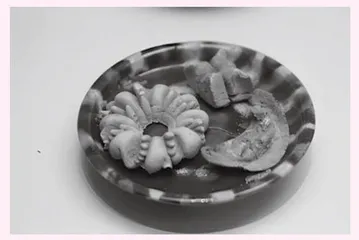A Brief History of Jiaozi 饺子简史

As archaeologists studied an ancient tomb in Turfan in western China, they discovered some surprisingly well-preserved and familiar relics. Though hardened over 1,000 years, there sat little crescent-shaped dumplings.
考古学家研究中国西部吐鲁番某处古墓时,发现了一些保存完好且熟悉的文物。尽管经过了一千年的硬化,月牙形的小饺子还是保存了下来。
According to history, dumplings first appeared during the Han Dynasty. Around 1,800 years ago, a physician named Zhang Zhongjing returned to his hometown during a cold winter. He found his fellow villagers with frostbitten ears and made a new dish to help them warm up. The dish was made up of mutton, herbs, and spices—ingredients he chose for their warming and medicinal properties. Zhang wrapped them in pieces of dough and folded the wrappers to resemble tiny ears.
据历史记载,饺子最早出现于汉代。大约1800年前,一位名叫张仲景的医生在一个寒冷的冬天回到了家乡。他发现村民的耳朵长着冻疮,于是制作了一道新菜来帮助他们取暖。这道菜里有羊肉、草药和香料,他选择这些原料是因为它们具有温阳和药用的特性。张仲景将它们包在面皮中,然后将面皮对折包成小耳朵的形状。
Dumplings continued to take off in China over the next thousand years. Instead of the traditional meat filling, some areas preferred vegetarian dumplings. People developed new cooking methods. And because wheat was harder to grow outside of northern China, those in other regions began making dumplings using rice, tapioca, and sweet potato. The relationship between Chinese dumplings and those in other areas is hard to trace, but food historians have made their best guesses based on available information.
在接下来的一千年里,饺子在中国不断发展。一些地区没有选择传统的肉馅,而偏好素饺子。人们研究出了新的烹饪方式。由于小麦较难在中国北方以外的地区种植,于是其他地区的人开始用大米、木薯和红薯包饺子。中国与其他地域的饺子的关系很难追溯,但食品历史学家根据现有的信息做出了最有把握的推测。
After Chinese dumplings were introduced to more countries, English speakers began calling them dumplings. The term means “little lumps” and is thought to have been first used in 16th-century England to describe dough balls dropped in liquid. Like knödel, they had no filling. So, the word was actually confusingly imprecise, but it became accepted. When Japan invaded China during the Second World War, Chinese jiaozi spread rapidly in Japan, where they in turn became known as “gyoza” and were more typically pan-fried.
后来,当中国饺子被引到更多国家后,母语为英语的人开始称它们为饺子。该词是“小块”的意思,被认为最早出现在16世纪的英国,用来形容在汤中的面团。像马铃薯球一样,它们没有馅料。因此,这个词实际上是不准确的,令人困惑,但它仍然被保留了下来。日本在第二次世界大战期间侵略中国时,中国的饺子在日本快速流行,在那里它们又被称为“gyoza”(日式饺子),更常见的是煎炸的饺子。
It’s unlikely that all dumpling-esque dishes came from the same tradition. In many cases, it may simply be that cooks from different cultures shared a similar inspiration: that cooking fillings covered in dough would be delightful. Either way, we can appreciate these plump pockets of perfection and the mysterious historical web that has made dumplings so diverse and wonderful.
不可能所有类似饺子的菜肴都源自同一个传统。在多数情况下,可能只是有着不同文化背景的烹饪家产生了类似的灵感:烹饪包着馅料的面团会让人喜欢。不管怎样,我们都可以享用到这些经过完善的饱满“口袋”,认识到让饺子变得如此绝妙、多样化的神秘历史渊源。